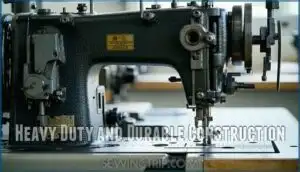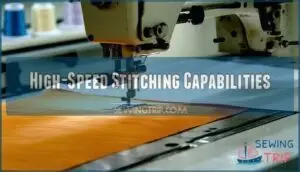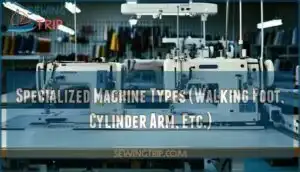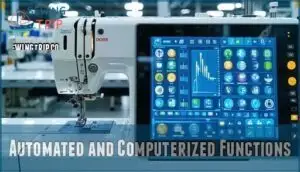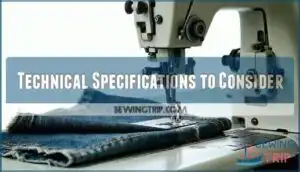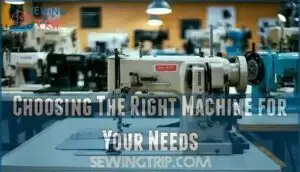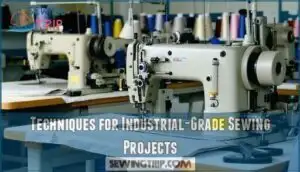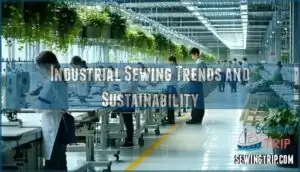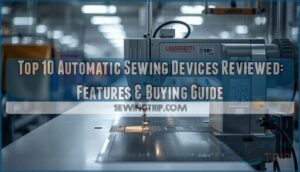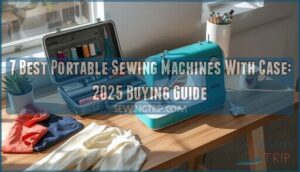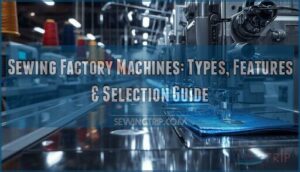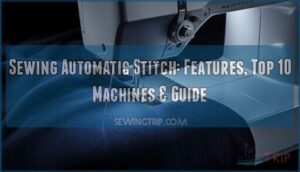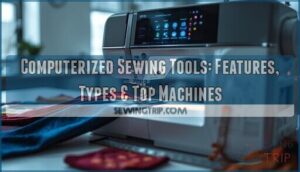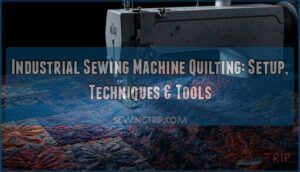This site is supported by our readers. We may earn a commission, at no cost to you, if you purchase through links.
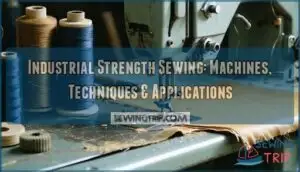
Industrial strength sewing isn’t about pushing a domestic machine harder—it’s about using equipment built from the ground up for power and speed. These machines punch through leather like paper, stitch a thousand times per minute without breaking a sweat, and run eight-hour shifts without overheating.
Whether you’re manufacturing car seats, military gear, or upholstery, the right machine transforms impossible projects into routine production work. The difference between industrial and domestic equipment comes down to motor power, frame construction, and specialized features designed for specific materials and applications.
Table Of Contents
Key Takeaways
- Industrial sewing machines deliver 60% more motor power and speeds exceeding 1,000 stitches per minute compared to domestic models, transforming thick materials and heavy-duty projects from impossible challenges into routine production work.
- Specialized machine types like walking foot, cylinder arm, and post bed designs solve specific material challenges—each feed mechanism prevents fabric shifting, wraps around curves, or handles large panels that would jam standard equipment.
- Automation and computerized controls now enable single operators to match entire teams’ output while AI integration catches problems before they halt production, though operator health remains critical with 93.9% experiencing low back pain from repetitive motion.
- The textile industry generates 10% of global carbon emissions and faces mounting pressure to balance rapid production speeds with sustainability through energy-efficient servo motors, waste reduction strategies, and ethical sourcing practices.
What is Industrial Strength Sewing?
Industrial strength sewing isn’t just about cranking up the speed on a regular machine. It’s a whole different approach built around power, precision, and working with materials that would make a home machine tap out.
Let’s break down what sets this world apart—from the terminology you need to know to the industries that depend on it every day.
Definition and Key Terminology
Industrial strength sewing isn’t just about bigger machines—it’s a whole different world of power, precision, and purpose-built equipment designed to tackle jobs that would snap a home machine in half. When you hear industrial terminology in a sewing context, you’re looking at machines built for three things:
- Heavy-duty construction that withstands thick fabrics and tough materials
- High-speed operation reaching over 1,000 stitches per minute
- Specialized machine types for specific industrial applications
The definition of industrial means equipment designed for manufacturing and production work, not hobby projects.
Historical Roots in The Industrial Revolution
The machines that made industrial strength sewing possible trace back to the late 1700s, when the Industrial Revolution flipped Britain—and eventually the world—from farms to factories. Early innovations in textile manufacturing created a massive demand for faster production methods.
Factories replaced home workshops and transformed labor conditions forever. This global spread of industrial production changed how clothing moved from craft to mass manufacturing. You’re looking at the birth of modern industrial applications in sewing.
Industrial Vs. Domestic Sewing
When you strip away the factory floor noise and production quotas, the gap between industrial and domestic machines comes down to raw power and purpose. Industrial sewing machines deliver consistent stitch quality through thick fabric layers that would jam home equipment. They manage heavy-duty sewing all day without overheating.
Domestic machines work well for hobby-scale projects but lack the motor strength and durability for commercial sewing machines demands.
Sectors and Industries Using Industrial Sewing
You’ll find industrial sewing machines running hard in sectors where domestic equipment would buckle under the workload. Apparel manufacturing and the textile industry drive the most volume.
Automotive textiles and aerospace applications demand precision stitching on technical fabrics. Medical textiles require sterile conditions and exact specifications.
Upholstery shops work with foam and leather daily. The geotextiles sector and sewn products industry round out the industrial sector’s reach.
Essential Features of Industrial Sewing Machines
You can’t build a solid industrial setup without knowing what separates a workhorse machine from a lightweight model. The right features make the difference between smooth production and constant downtime.
Here’s what you need to look for when choosing equipment that won’t let you down.
Heavy Duty and Durable Construction
An all-metal frame isn’t just for show—it’s the backbone that keeps your industrial machine stitching straight through years of punishing work. Here’s what makes a durable frame essential:
- All-metal interior resists vibration and wobble during high-volume runs
- Stronger motor mounts securely to the metal frame for consistent power delivery
- Long-lasting precision comes from rigid construction that won’t flex under pressure
- Thick seams demand a heavy-duty build that won’t buckle mid-project
- Metal frame construction outlasts plastic alternatives by decades in factory settings
This sturdy design gives you the edge when production can’t stop.
High-Speed Stitching Capabilities
Speed separates hobbyists from high-volume pros. Industrial machines deliver faster stitching that transforms manufacturing processes—top models hit over 6,000 stitches per minute while your home machine barely reaches 700. This velocity drives productivity gains that let you crush deadlines and scale up without adding shifts.
| Speed Tier | Stitches Per Minute | Best For |
|---|---|---|
| Entry Industrial | 1,100–1,600 | Medium-duty apparel, upholstery |
| High-Speed Standard | 1,600–3,500 | Mass garment production, automotive textiles |
| Ultra High-Speed | 3,500–6,000+ | Fast-fashion assembly lines, technical fabrics |
| Computerized Automation | Variable (optimized per task) | Precision work requiring stitch consistency |
| Heavy Duty Specialized | 800–1,500 | Leather goods, thick layered materials |
Automation integration and technological advancements push these machines further. Computerized controls adjust tension and stitch length on the fly, cutting waste and rework. Energy efficiency improvements in newer models offset higher power demands, appealing to factories chasing sustainability goals. The industry sees advancements in AI-driven adjustments for real-time precision.
Market growth in high-speed segments—up 15–20% annually—proves that faster stitching isn’t a luxury. It’s the baseline for staying competitive in today’s race.
Specialized Machine Types (Walking Foot, Cylinder Arm, Etc.)
Different fabrics demand different tools, and that’s where specialized industrial machines prove their worth. Walking foot sewing machines grip layers from top and bottom so thick materials don’t shift. Cylinder arm models wrap around tubular pieces like sleeves and cuffs. Post bed designs work with intricate curves on shoes and bags. Flat bed machines tackle large panels. Long arm features give you room for quilts and upholstery. Each feed mechanism solves a specific challenge you’ll face on the floor.
Automated and Computerized Functions
Automation hands off the repetitive work so you can focus on precision and speed that human hands alone can’t match. Computerized equipment setup adjusts tension and stitch length at the touch of a screen. Smart sensors detect thread breaks before they ruin a seam. Automated thread trimmers cut loose ends instantly.
Remote control lets supervisors monitor multiple machines across the floor. Predictive maintenance alerts you before breakdowns happen. Digital patternmaking feeds directly into robotics integration for fluid production runs.
Technical Specifications to Consider
Motor power separates machines that struggle from those that punch through twelve layers of denim without hesitation. When you evaluate machine specifications, prioritize these measurable features:
- Motor strength delivering 60% more power tackles thick seams and tough fabrics
- Stitching speed reaching 1,100 stitches per minute for domestic models or exceeding 7,000 RPM in professional settings
- Frame durability with all-metal construction ensures long-lasting precision across fabric types
Match stitch options and automation features to your needle requirements and weaving projects. A machine with a strong motor is essential for dense materials.
Choosing The Right Machine for Your Needs
Picking the right industrial sewing machine isn’t about grabbing the fanciest model on the shelf. You need to match your machine to the work you’re doing and the materials you’re using.
Let’s break down what you should consider when shopping for your next workhorse.
Assessing Project and Fabric Requirements
Before you buy your next machine, you need to know exactly what you’re sewing and how often you’ll push it to the limit. Think about fabric weight first. Are you working with heavyweight materials like canvas and denim or lighter stuff?
Thick seams and tough fabrics demand serious stitch density and seam strength. Match material compatibility to your sewing applications.
Project complexity matters too because different fabric types need different needle and thread setups.
Leading Industrial Sewing Machine Brands
Once you’ve nailed down your fabric needs, you need to focus on who’s building the machine. Here’s what separates the leaders from the rest:
- JUKI operates in 185 countries with specialized machines like denim chain-stitchers
- Brother Industries holds a top-three position globally through automation R&D
- Singer reinforces loyalty with their "Sew It Forward" app for Wi-Fi models
- The five largest brands controlled over 50% of market revenue in 2024
These industrial sewing machine brands didn’t just stumble into market dominance. JUKI leverages decades of mechanical expertise, while Dürkopp Adler owns the automotive and footwear niches. Regional presence matters too, as Asia-Pacific leads with 51% of total revenue. Innovation strategies and sustainability initiatives now define brand specialization across the industry.
Comparing Machine Models (e.g., SINGER, Long Arm, Serger)
Now that you know which brands dominate the market, you need to match specific machine types to your actual workload. Each sewing machine type solves different production challenges, so model features and brand differences matter when you compare options.
A SINGER lockstitch addresses straight seams in apparel. Long arm machines tackle quilting and large-scale projects. Sergers finish edges with overlock stitches.
Pricing, Warranty, and Support Details
After you pick the right machine type, you need to know what you’ll actually pay and what protection you get when problems surface. Machine cost ranges from a few hundred dollars to several thousand depending on features. Warranty length varies by brand but usually covers one to five years.
Support availability includes technical support and customer service through phone or online channels. Some manufacturers bundle maintenance packages and training options into the sewing machine ordering process.
Techniques for Industrial-Grade Sewing Projects
Industrial sewing isn’t just about having the right machine. You need to know how to work with different materials and set up your workspace for specific projects.
Here’s what you need to master for professional results.
Preparing for Thick and Tough Fabrics
Thick fabrics can turn even a powerful machine into a struggling mess if you don’t prep your workspace and settings first. Here’s what you need to lock down before tackling heavy weight materials like canvas or leather sewing:
- Needle selection – Use size 18-20 for canvas and thick fabric sewing
- Thread choice – Match thread strength to fabric weight
- Foot pressure – Adjust to prevent fabric shifting
- Stitch length – Increase for heavy materials
- Seam finishes – Test on scraps first
These adjustments give you control when working with tough fabrics.
Setting Up for Home Decor and Upholstery
Home decor projects demand different machine settings than regular sewing because upholstery fabrics weigh more and pile thicker at seams. Start by setting up your workspace with adequate lighting and table space for large fabric panels.
A walking foot attachment prevents shifting during upholstery work. Use heavyweight thread and adjust presser foot pressure to match your fabric selection. Test seam techniques on scraps before starting your project planning phase.
Sewing Leather and Heavy Materials
Leather pushes your machine harder than any fabric you’ve worked with because it won’t forgive weak stitches or incorrect tension settings.
Switch to leather sewing needles with sharp wedge points and use bonded polyester thread for strength. Walking foot machines grip heavy materials without slippage.
Reinforce stress points with double stitching and finish edges with edge paint or binding tape for a clean look.
Common Industrial Sewing Applications (Apparel, Quilting, Drapery)
Industrial machines power different markets with distinct demands. Apparel production drives the largest volume with high-speed lockstitch and overlock machines for garment assembly. Quilting applications rely on long-arm machines that manage bulky layers and intricate patterns across wide surfaces. Drapery construction uses heavy-duty straight-stitch and blind-hem machines for clean finishes on stiff decorator fabrics.
Each application demands specific fabric control skills:
- Apparel: Fast seam construction with consistent tension control
- Quilting: Layer management and pattern precision over large areas
- Drapery: Accurate hems and pleats in thick woven materials
- Design Applications: Custom details requiring specialized presser feet
- Sewing Techniques: Speed adjustments matching material weight and complexity
Maintenance and Safety Best Practices
Your machine won’t save you if you skip the basics that keep it running strong. Machine lubrication keeps moving parts smooth and prevents premature wear. Needle replacement ensures clean stitches and prevents fabric damage. Workplace ergonomics reduces operator fatigue during long production runs.
| Maintenance Task | Frequency | Key Benefits |
|---|---|---|
| Machine Lubrication | Daily | Extends sewing machine parts and supplies lifespan |
| Needle Replacement | Per project | Prevents thread breaks and skipped stitches |
| Electrical Safety Check | Weekly | Protects automated equipment setup from power surges |
Contact sewing machine technical support for warranty information and emergency procedures training.
Industrial Sewing Trends and Sustainability
The industrial sewing world is changing fast. New technologies are reshaping how factories operate while raising important questions about worker wellbeing and environmental impact.
Here’s what you need to know about where the industry stands today and where it’s headed tomorrow.
Automation and Smart Sewing Technologies
Automated and computerized sewing machines have turned production floors into precision powerhouses where a single operator can match what once took an entire team. Smart sewing systems with AI integration and predictive maintenance catch problems before they slow you down. Direct drive sewing machines and robotic sewing units take care of automated equipment setup in seconds.
Key advantages you gain:
- Automated stitching cuts production times and lets you accommodate higher order volumes
- Electronic tackers and computerized industrial sewing machines deliver consistent stitch quality that reduces defects
- Automated equipment with robotic precision gives you control over complex patterns without the headaches
Impact on Apparel and Textile Manufacturing
Apparel manufacturing equipment has become the backbone of global clothing production, with Asia-Pacific factories leading the charge. In 2024, the U.S. shipped textile industry supplies worth USD 63.9 billion. Industrial sewing machines drive production efficiency, enabling rapid scaling of operations, while design innovation offers opportunities for custom garments and complex material integration. Quality consistency from automated stitching reduces defects and enhances customer retention. However, the environmental impact remains a challenge as the industry grapples with waste and carbon emissions.
| Impact Area | Key Outcome |
|---|---|
| Production efficiency | Automated machines cut production times and boost order volumes |
| Market growth | Global market projected to reach USD 5.4 billion by 2034 |
| Design innovation | Fluid joining of diverse materials and rapid prototyping |
| Quality consistency | Uniform seams reduce garment failure rates and rework |
| Environmental impact | Fast fashion waste countered by recycling and circular economy efforts |
Textile industry supplies and garment apparel manufacturing now strive to balance speed with sustainability as weaving technology advances.
Operator Health and Ergonomics
Behind every rapid production line and perfectly sewn garment sits an operator whose body takes the toll of repetitive motion and long hours hunched over a machine. Studies reveal staggering pain rates among sewing machine operators: 93.9% experience low back pain, and 76% suffer neck pain. Posture improvement and injury prevention demand urgent attention through ergonomic accessories and workplace design.
Industrial sewing operators face severe health costs: 94% suffer low back pain and 76% endure neck pain from repetitive motion
Key ergonomics strategies for industrial sewing applications:
- Adjustable workstations – Height-matched tables and chairs reduce strain during sewing techniques
- Training programs – Proper body mechanics education protects operators on every industrial sewing machine
- Regular breaks – Micro-pauses interrupt repetitive patterns in industrial applications
- Supportive equipment – Lumbar cushions and footrests transform weaving and stitching comfort
Environmental Considerations in Industrial Sewing
The carbon footprint of your factory’s machines extends far beyond the electricity meter on the wall. The textile industry shoulders 10% of global carbon emissions through fossil-fuel dependence in industrial applications.
Energy consumption drops when you switch to LED lighting and servo motors. Waste reduction cuts costs, while sustainable materials and ethical sourcing reshape sewn products.
Chemical usage in weaving demands scrutiny as regulations tighten across sewing applications.
Market Growth and Future Outlook
Sustainability concerns now drive momentum alongside proven market expansion. Watch for these shifts:
- Strategic Investments in automation adoption are accelerating as textile industry leaders pour resources into servo motors and smart industrial sewing machine systems
- Regional Consumption patterns favor Asia-Pacific dominance, with market CAGR projections reaching 4.5% value growth through 2035
- Export Growth and commercial applications continue expanding across weaving and apparel sectors globally
North American revenue climbs toward $720 million by 2033 as manufacturers embrace efficiency-driven technologies.
Frequently Asked Questions (FAQs)
How do I thread an industrial sewing machine?
Before smartphones revolutionized workflow, operators mastered threading by hand. Start by raising the needle to its highest point. Guide thread through tension settings and bobbin winding paths. Match needle types to your fabric weight and always check for jams.
What needle sizes work for different fabric weights?
Choosing the right needle matters when you work with different materials. Light fabrics need size 9 or 11 needles. Medium weight cloth works well with size Heavy materials require size 16 or Extremely heavy materials like leather demand size 20 or higher to prevent breakage.
Can industrial machines sew stretchy or knit fabrics?
Yes, but you need the right setup. Use a ballpoint or stretch needle to prevent skipped stitches. Select a zigzag or stretch stitch type.
Adjust differential feed to avoid puckering. Lower tension settings help stretchy fabrics move smoothly without distortion.
How do I troubleshoot common industrial machine problems?
When thread breakage happens repeatedly, check your needle issues first. Tension problems often stem from improper threading or debris buildup.
Motor malfunction and timing adjustments require Sewing Machine Technical Support or replacement parts from Sewing Machine Parts and Supplies vendors.
What training is needed to operate industrial equipment?
You’ll need hands-on training in safety protocols, machine maintenance, troubleshooting skills, and fabric management.
Commercial sewing operations require mastering sophisticated techniques through sewing machine lessons and technical support guidance for industrial applications.
Conclusion
Don’t let your projects hang by a thread. Industrial strength sewing machines deliver the raw power and precision needed to turn heavy-duty materials into finished products without compromise.
You’ve learned what separates industrial equipment from domestic models, how to match machines to materials, and which techniques keep production running smoothly.
Now it’s about putting that knowledge to work. The right machine doesn’t just complete jobs—it redefines what’s possible in your workshop, transforming challenging projects into repeatable success.
- https://www.indexbox.io/blog/industrial-sewing-machine-world-market-overview-2024-3/
- https://www.gminsights.com/industry-analysis/industrial-sewing-machine-market
- https://www.accio.com/business/best-industrial-sewing-machine
- https://www.alliedmarketresearch.com/industrial-sewing-machines-market-A06634
- https://industrialsewingmachine.global.brother/en-ap/news/2020/data-trend-from-nexio-system---dec-2020

